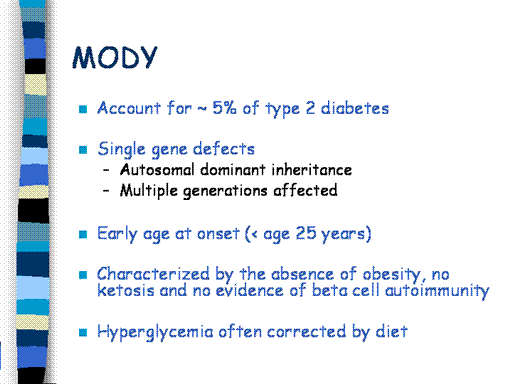| front |1 |2 |3 |4 |5 |6 |7 |8 |9 |10 |11 |12 |13 |14 |15 |16 |17 |18 |19 |20 |21 |22 |23 |24 | 25|26 |27 |28 |29 |30 |31 |32 |33 |34 |35 |36 |37 |38 |39 |40 |41 |42 |43 |44 |45 |46 |47 |48 |49 |50 |51 |52 |53 |54 |review |
 |
Another type
of diabetes that occurs in children and young adults is maturity onset
diabetes of the young (MODY).
MODY is a rare form of T2D, and accounts in only ~5% of all T2D cases.
MODY is caused by a mutation in a gene involved in either
pancreatic development, insulin gene expression, or glucose sensing.
MODY follows an autosomal dominant pattern of inheritance. Thus,
in families, affected
individuals
will usually carry only one copy of the mutant gene; and MODY it is
frequently observed in
every generation. Unlike T1D and T2D
which are both polygenic and multifactorial, MODY is directly
inherited.
MODY is characterized by the absence of obesity, no ketosis and
no evidence of beta cell autoimmunity.
MODY generally
presents as mild type 2 diabetes and is most often diagnosed before age
25 years.
Because MODY occurs in children, it is sometimes misdiagnosed as
T1D. Young women with MODY
are also frequently diagnosed during pregnancy. MODY often can be
managed without insulin although some individuals with MODY will need to
have insulin injections at a later age.
|